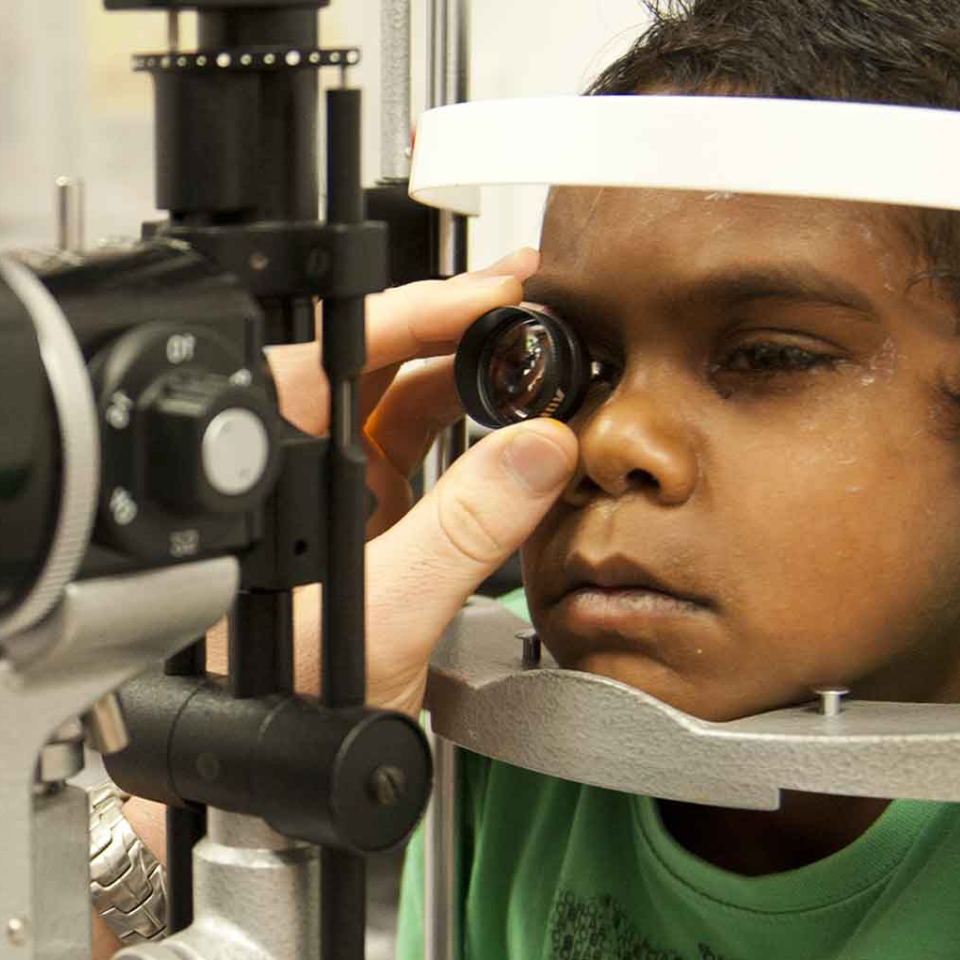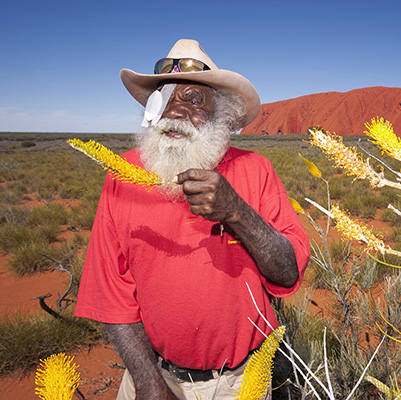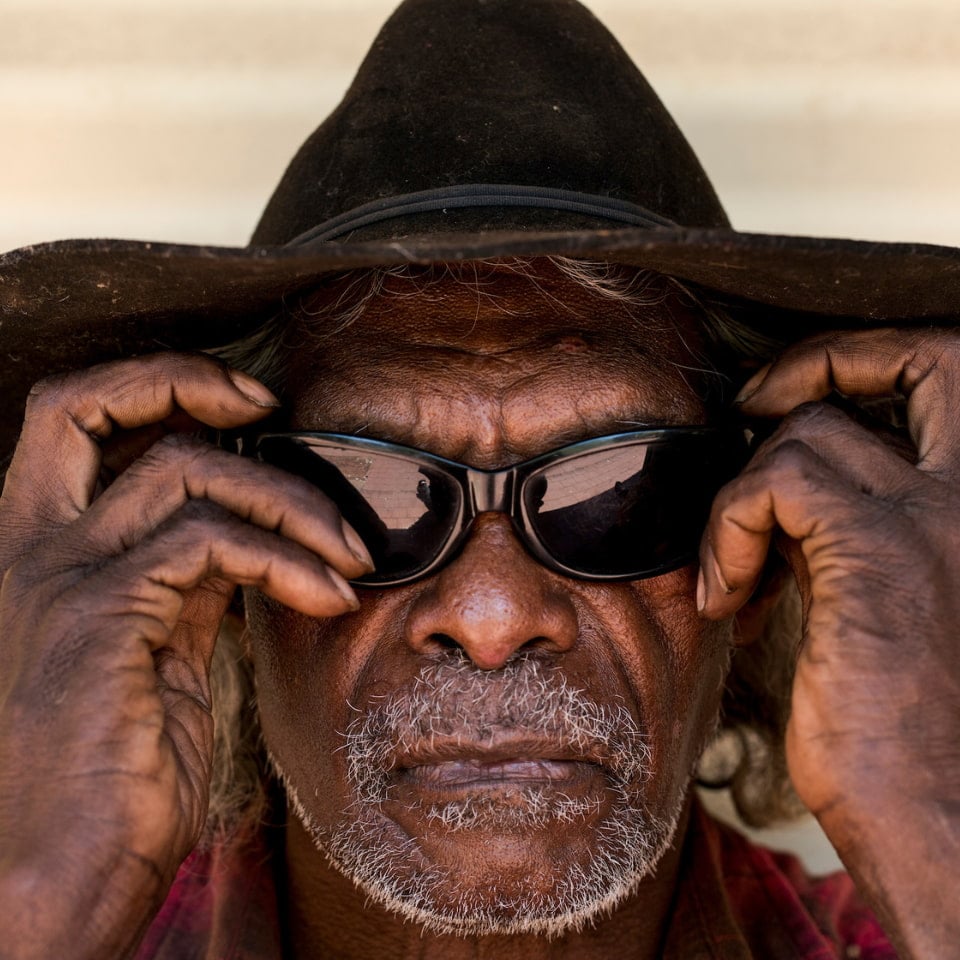Aboriginal and Torres Strait Islander children generally have better vision than other Australian children. As adults however, Aboriginal and Torres Strait Islander people are three times more likely to go blind.
It's no secret that Aboriginal and Torres Strait Islander people have poorer health outcomes than non-Indigenous Australians.
However, something can be done.
Since 2006, Australia's peak health bodies, NGOs and human rights organisations have worked together, aiming to achieve health and life expectancy equality for Aboriginal and Torres Strait Islander people.
This is called the 'Close the Gap' Campaign.
The Fred Hollows Foundation actively participates in and supports the steering committee of the campaign.
Today, there’s still a gap in life and health expectancy between Aboriginal and Torres Strait Islander people and non-Indigenous Australians. Poor eye health and a lack of access to services play a part in this.
The Close the Gap campaign is working to change this.
By coming together to improve health systems, and advocating for bipartisan support and long-term funding and solutions, we believe that by 2030, every Aboriginal and Torres Strait Islander child could live a long and healthy life – like any other Australian child.
Here's what we'll cover...
Click on the link to jump to sections that you're most interested in.
- What is Close the Gap?
- What is the history of Close the Gap in Australia?
- What is National Close the Gap Day?
- Why does 'The Gap' exist?
- What are the social and cultural factors that can influence Aboriginal and Torres Strait Islander health outcomes?
- What is the Eye Health Gap?
- What is The Fred Hollows Foundation doing about it?
- Why is The Fred Hollows Foundation involved in Close the Gap?
- 5 things we can all do to help Close the Gap
What is close the gap?
‘The Gap’ refers to the difference in health outcomes between Aboriginal and Torres Strait Islander Australians and non-Indigenous Australians. For example, Aboriginal and Torres Strait Islander Australians can expect to live 10 years less than other Australians.
The goal of the Close the Gap campaign is to achieve health equity and reduce the life expectancy gap within a generation.
What is the history of close the gap in Australia?
In 2005, the Aboriginal and Torres Strait Islander Social Justice Commissioner Tom Calma called for swift action from all Australian governments to tackle life expectancy inequalities.
Calma's idea led to collective action over the next few years with the formation of the National Indigenous Health Equality Campaign, the Close the Gap campaign and eventually, the National Close the Gap Day.
These campaigns resulted in a commitment at the end of 2007 from the Council of Australian Governments (COAG) to close key gaps. Within a year, COAG identified six targets:
- to close the life expectancy gap within a generation
- to halve the gap in mortality rates for Indigenous children under five within a decade
- to ensure access to early childhood education for all Indigenous four year olds in remote communities within five years
- to halve the gap in reading, writing and numeracy achievements for children within a decade
- to halve the gap for Indigenous students in year 12 attainment rates by 2020 and
- to halve the gap in employment outcomes within a decade.
However, in 2018, a 10-year review found that Government’s Closing the Gap strategy had only been partially implemented and that a refreshed strategy would require equitable investment in Aboriginal and Torres Strait Islander health.
In 2019, The Federal Government reported that only two of the seven targets were on track:
- To have 95 percent of all Indigenous four-year-olds enrolled in early childhood education by 2025
- To halve the gap in Year 12 attainment by 2020
The Government has now committed to a genuine, formal partnership between Aboriginal and Torres Strait Islander representatives and COAG on a refresh of the Closing the Gap strategy.

What is National Close the Gap Day?
National Close the Gap Day is Australia’s largest Aboriginal and Torres Strait Islander health campaign.
It’s an initiative to encourage community support and raise awareness about the unacceptable health inequality that Indigenous Australians experience.
At The Fred Hollows Foundation, much of our work focuses on eye health in Indigenous communities. But change will only come if we create awareness and take action
Why does 'the gap' exist?
We live in a relatively wealthy, clean and safe country, but many Aboriginal and Torres Strait Islander people still experience poorer health outcomes and unacceptable living conditions than their non-indigenous counterparts.
Everyone has the right to access appropriate health care close to where they live, and right now not all health services are available to Aboriginal and Torres Strait Islander people. In rural and remote areas there are not enough trained staff to carry out treatments and surgeries. This often results in patients being required to wait a long time to access services, or to travel a long way to receive diagnosis and/or treatment.
As a result, Aboriginal and Torres Strait Islander people may live with health conditions for years without diagnosis or required treatments and follow up consultations.
Furthermore, poor housing and living conditions, and limited health literacy amongst patients can cause difficulty navigating the health system.
Importantly, culturally safe primary health care services, in particular Aboriginal Community Controlled Health services, do not receive adequate funding to meet the health needs of Aboriginal and Torres Strait Islander people.
Social and cultural factors can also influence Indigenous health outcomes
The mainstream health service also needs to be culturally safe, accessible and responsive. For many Aboriginal people, hospitals can be alienating places. To some Aboriginal and Torres Strait Islander patients hospitals are a place associated with illness and death, rather than treatment.
Patients also experience negative attitudes and interactions including racism and discrimination from hospital staff, due to a lack of culturally competent staff.
Another factor contributing to people not attending clinics or hospitals are their cultural practices around men and women’s business. A culturally safe space for some Aboriginal and Torrest Strait Islander patients is one where two separate spaces are provided for men and women with appropriately trained staff.
When staff are appropriately trained and understand subtle cultural protocols, patients will feel safer to attend clinics to receive required medical treatments when they are available within the community, this includes outreach optometry and ophthalmology!
Other factors such as unsafe and inadequate housing also impact on health outcomes. Safe housing with well maintained health hardware, such as working taps and showers, are essential to addressing diseases such as trachoma.
What is the eye health gap?
When it comes to eye health, Aboriginal and Torres Strait Islander adults are:
- Three times more likely than other Australians to go blind
- 12 times more likely to have blinding cataract than other Australians
- Four times more likely to wait for more than one year for eye surgery than other Australians
What’s more:
- 94 per cent of vision loss for Aboriginal and Torres Strait Islander adults is preventable or treatable
- 35 per cent of Aboriginal and Torres Strait Islander adults have never had an eye exam
- Australia is also the only high-income country in the world where the blinding eye disease trachoma still exists
- Trachoma is the fourth leading cause of blindness among Aboriginal people
- Trachoma can be eliminated if the WHO SAFE strategy is fully implemented
- An estimated 37 per cent of Aboriginal and Torres Strait Islander adults have diabetes
- One in three has diabetic retinopathy
- But 98 per cent of blindness from diabetes is preventable.
- There is only one ophthalmologist in the Central Australia region, an area the size of Spain.
Here's one of many 'Fred moments' that our supporters have helped us to create
What is the Fred Hollows Foundation doing about it?
We support Aboriginal and Torres Strait Islander people exercise their right to good health and access the eye health services they need, when and where they need them.
Our Indigenous Australia Program supports increased investment in culturally-appropriate eye care services for Aboriginal and Torres Strait Islander communities.
We're working to:
- Deliver surgery and medical treatment for cataract, refractive error, diabetic retinopathy and the elimination of trachoma
- Increase access to services
- Coordinate and improve outreach services so everyone who needs medical care receives it
- Provide training and support to Aboriginal and Torres Strait Islander health staff and improve the cultural safety of mainstream services
Why is the Fred Hollows Foundation involved in close the gap?
"We cannot go on as a modern country living with this scandalous situation of Aboriginal living conditions in Central Australia," Fred said in the late 1960s.
While working at Prince of Wales Hospital, he treated two Aboriginal patients with an eye problem he’d never seen before – trachoma.
“Until Aboriginal people share the same basic conditions of hygiene, sound diet, insect-proof housing, sanitation and clean water which whites take so much for granted, Aboriginal people in rural parts of the country will continue to be afflicted with avoidable disease such as trachoma” - Fred Hollows, 1980, In Fred’s Footsteps.
Fred was shocked by the prevalence of a disease he didn’t think existed in modern Australia.
It was this shock that led Fred to help set up the first Aboriginal Medical Centre and help form the National Trachoma and Eye Health Program in 1975.
Our commitment to Close the Gap continues Fred’s work and the legacy he left us as The Fred Hollows Foundation.
5 things we can all do to help close the gap
In 2017, 150,000 Australians participated in 1,596 Close the Gap events across the country. If you can't attend an event, there's still plenty you can do:
#1 Educate yourself
Read how to build respect and relationships via the Share Our Pride website.
#2 Get a (politician) pen pal
Write to your local MP and the Ministers for Health and Indigenous Affairs asking them to support the call for an extra $85.5 million over five years to help close the gap in eye health.
#3 March proud
Take part in a Close the Gap Day event in March.
#4 Be social
Here are three ways you can be social:
- 'Like' the Close the Gap Facebook page
- Spread awareness and tell your family and friends about the current state of health for Indigenous Australians; and
- Share this article with your social networks so more people know exactly what the Gap is and why we need to Close it.
Let's be part of the generation that makes a change and closes the gap for good.

Did you know?
- Aboriginal and Torres Strait Islander people can expect to live substantially shorter lives than other Australians (on average 10 to 17 years less).
- Babies born to Aboriginal mothers die at twice the rate of other Australian babies.
- Indigenous Australians are three times more likely to go blind than the rest of the population.
- 35 percent of Aboriginal and Torres Strait Islander adults have never had an eye exam. This is despite 94 percent of vision loss among Aboriginal and Torres Strait Islander adults being preventable or treatable.
